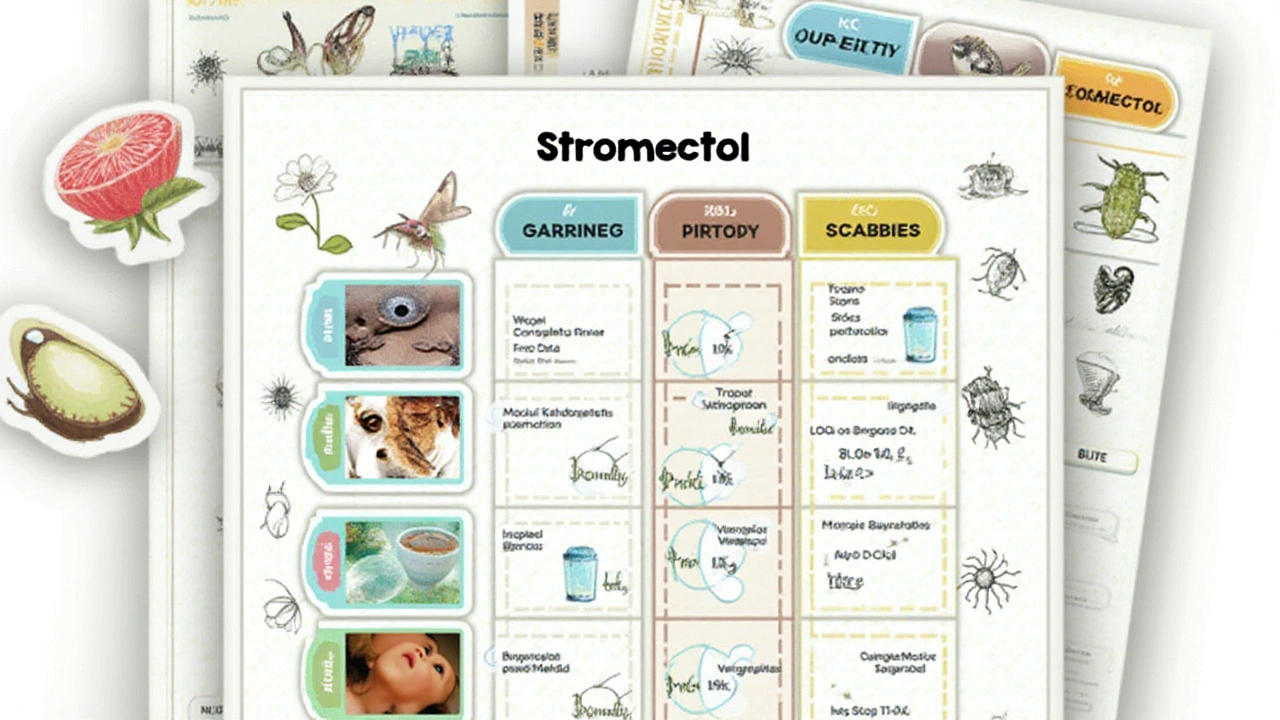In recent years, medical science has developed numerous drugs to tackle parasitic infections, providing essential alternatives to well-known medications like Stromectol. Understanding these options is crucial as they offer specialized treatment methods against various parasites.
This article delves into eight such alternatives, shedding light on their specific uses, benefits, and drawbacks. Whether you're dealing with river blindness or aiming to manage a lice infestation, these alternatives might provide the solution you need.
Join us as we explore the pharmacological landscape of parasitic treatments available in 2024, equipping you with valuable insights into the world of antiparasitic medication.
- Moxidectin
- Albenza (Albendazole)
- Biltricide (Praziquantel)
- Emverm (Mebendazole)
- Pyrantel
- Alinia (Nitazoxanide)
- Malathion
- Lindane
- Conclusion
Moxidectin
Moxidectin stands as a robust alternative in the fight against parasitic diseases, particularly for its effectiveness against river blindness or onchocerciasis. This condition affects millions worldwide, predominantly in Africa. Moxidectin's appeal lies in its long half-life, meaning it stays active in the body far longer than some other drugs, including Ivermectin, which is traditionally used for similar purposes. This longer duration translates to less frequent dosing schedules, potentially improving adherence to treatment regimes. Patients appreciate this feature as it can reduce the burden of ongoing medical routines.
The drug operates as a potent microfilaricide, which means it targets and annihilates the microscopic worms causing the disease. Compared to Ivermectin, Moxidectin might offer enhanced efficacy, a significant consideration in regions where river blindness is rampant. Approving it was a step forward in providing alternatives like these, broadening the options available for healthcare practitioners in treating severe parasitic infections.
Pros
- Longer half-life, making it convenient with less frequent dosing.
- More potent microfilaricide, effectively tackling parasitic worms causing river blindness.
- FDA-approved for treating river blindness, ensuring a level of safety and efficacy in practice.
One exciting aspect of Moxidectin is its background. Developed initially for veterinary use, its leap into human medicine was spurred by its success against parasites in animals. It highlights the innovative cross-pollination between veterinary and human medicine, where treatments effective in the animal kingdom can sometimes transition to humans under specific conditions.
"Moxidectin represents a promising alternative to Ivermectin, potentially changing the approach to treating onchocerciasis," said Dr. John Gyapong, a key figure in global health research.
However, it's not without its drawbacks. While it's been a phenomenal addition to the toolkit for river blindness, ongoing studies are vital to establishing its safety profile, especially in children and women who could become pregnant. Despite these concerns, Moxidectin offers hope for affected communities, providing a more effective solution in areas with limited access to healthcare.
Cons
- The need for additional clinical trials to assess safety, especially in younger populations and women of childbearing potential.
Reflecting on its track record, Moxidectin's journey from a veterinary antiparasitic agent to a crucial drug for human use showcases the adaptive nature of science and medicine. Series of rigorous tests and trials provided the necessary data to expand its use. It has not only improved patient outcomes but also paved the way for future drug developments targeting other diseases. These new insights and applications make it a valuable alternative in the arsenal against parasitic diseases, directly addressing the needs highlighted by medical professionals battling these infections every day.
Albenza (Albendazole)
Albenza, also known as Albendazole, has long been valued in the medical community for its broad-spectrum efficacy in tackling a variety of parasitic infections. Primarily used to address infestations caused by nematodes or roundworms, the drug plays a critical role in the health sector by managing diseases like Echinococcosis and Giardia. These infections, often affecting individuals in underdeveloped regions, can have severe impacts on public health and quality of life. In fact, Albendazole's ability to penetrate tissues and target systemic indicatives of these parasitic provocations makes it a cornerstone in antiparasitic therapy. With its expansive reach, Albenza is not just limited to one category of parasites but shines across a spectrum, offering relief where other medications might fall short.
Historically, Albendazole has been utilized in mass drug administration programs aimed at reducing the parasitic burden on communities. Its success can be attributed to its remarkable ability to disrupt the energy production of parasites, rendering them unable to survive within the human body. This mechanism of action is particularly useful in treating hydatid disease and neurocysticercosis, conditions that require efficient and systemic action. A noted feature is that Albenza's active ingredient is metabolized in the liver, hence ensuring prolonged activity against the parasites. This method of action has been widely studied, with research consistently corroborating its effectiveness.
However, every coin has two sides, and the use of Albendazole is no exception. Patients might experience side effects, which can range from mild to moderate. These usually include nausea, dizziness, or abdominal pain, which are commonly reported but remain manageable under medical supervision. Unlike Stromectol, Albendazole may not match up in terms of effectiveness against onchocerciasis, which showcases the need for precise medical guidance when choosing the right treatment. That said, it remains one of the preferred options for treating cases where other similar drugs show limited efficacy.
In some reports, medical practitioners have highlighted the need for enhanced patient education regarding dosing regimens. Misunderstandings in this aspect can lead to suboptimal treatment (
"We must ensure patients fully understand dosing instructions to maximize Albendazole's benefits," suggests renowned parasitologist Dr. Marcus Lentz.). Given the complex nature of diseases that Albendazole targets, such information dissemination can be crucial. This underscores the need for supportive medical infrastructure in rural settings where these infections are most prevalent.
The safety profile of Albendazole indicates it's generally safe for adult populations, although caution is needed when prescribed to pregnant women or individuals with pre-existing liver conditions. Continuous research is vital in improving the safety and efficacy of Albenza, with recent studies motivated by the urgent need to control emerging challenges in parasitology. As we advance, integrating Albendazole into a comprehensive treatment plan that includes preventative measures and education remains a priority in truly overcoming the complexities of parasitic diseases.
Biltricide (Praziquantel)
Biltricide, known scientifically as Praziquantel, is a renowned broad-spectrum anthelmintic medication primarily used to target and eliminate infections caused by trematodes and cestodes. This includes infamous parasites like schistosomes and tapeworms that reside in human bodies, often causing debilitating diseases. Schistosomiasis, a dangerous condition linked to intricate life cycles involving freshwater snails and resulting in significant health burdens globally, particularly in poorer regions, sees effective intervention through Biltricide. This drug's biotechnology allows it to alter the permeability of cell membranes in these parasites, effectively paralyzing and eventually destroying them. This mechanism of action is pivotal in combatting infections that might otherwise lead to severe health deterioration over time.
One of Biltricide's significant strengths lies in its expansive efficacy against a range of parasites, making it a versatile tool in the medical arsenal against parasitic infections. It is widely prescribed for managing diverse conditions, providing relief for those suffering from the symptoms and complications of these parasitic invasions. Through extensive research and clinical trials, its safety profile has been well-established, permitting it to be licensed and approved for use in numerous countries around the globe. What sets Biltricide apart is not only its effectiveness but also its adaptability in various treatment regimens.
Pros
- Broad-spectrum efficacy against both trematodes and cestodes, making it highly versatile in treating multiple parasitic infections.
- Established use for managing significant health conditions like schistosomiasis, reducing the global disease burden.
- Approved for use in numerous countries, indicating a robust safety profile based on extensive clinical testing.
Cons
- Although effective, it is not specifically indicated for onchocerciasis, where alternatives like ivermectin might be more suitable.
- Like any medication, it can have side effects, which may include nausea, dizziness, and discomfort, necessitating careful patient monitoring.
It is worth noting that while Biltricide addresses a myriad of parasitic infections, it is contraindicated in patients with ocular cysticercosis, a rare but critical condition. This highlights the complex considerations involved in prescribing this medication, encapsulating the broader narrative of medication tailored to individual needs and conditions. As parasitic resistance becomes a mounting challenge, the role of Biltricide remains pivotal, ensuring effective management of these infections across various settings.
"Praziquantel's pivotal role in controlling schistosomiasis has been validated by decades of scientific research and field implementation, profoundly impacting public health outcomes." - World Health Organization
In the realm of healthcare, Biltricide demonstrates the need for a multifaceted approach to treating parasitic infections. Its place in the spectrum of alternatives to Stromectol is both secured and dynamic, proving that, with the right knowledge and application, even the most stubborn parasites can be tackled effectively. The conversations around antiparasitic treatments continue to evolve, guided by scientific advancements and the collective efforts of healthcare providers worldwide.

Emverm (Mebendazole)
When it comes to the realm of antiparasitic medications, Emverm, also known by its generic name Mebendazole, stands as a steadfast contender. This drug has carved its niche in treating infections caused by nematodes, or more commonly known as roundworms. Such infections include pinworm, hookworm, and whipworm infestations, which are prevalent in various regions worldwide. Mebendazole operates by inhibiting the microtubule formation in the parasites, effectively paralyzing and subsequently killing the unwelcome guests in the intestinal tract. This mechanism ensures that it deals a significant blow to a wide array of parasitic infections, a characteristic that makes it an important alternative to Stromectol.
One of the compelling aspects of Emverm is its accessibility and administration ease. Typically, the drug is offered in chewable tablets, which can be appealing and practical for both children and adults who might struggle with swallowing pills. What's noteworthy about Mebendazole is its minimalistic absorption in the bloodstream, which means its action predominantly remains within the gastrointestinal tract, curbing systemic side effects. However, like all medications, it does come with its cons. While it's highly effective on intestinal parasites, it doesn't offer the same level of efficacy for infections like onchocerciasis, where Stromectol might still hold sway.
According to Dr. Carla Geary, a renowned parasitologist, "Mebendazole has transformed the management of worm infections, especially in regions heavily burdened by such parasites. Its role in public health is indispensable."
While the effectiveness of Emverm is well-documented, it also requires vigilance regarding potential side effects. Users may experience gastrointestinal discomfort, such as abdominal pain or diarrhea, commonly associated with antiparasitic treatment where the body expels dead parasites. Nevertheless, severe adverse reactions are rare. For people looking for a reliable alternative to Stromectol, especially in cases where treatment focuses on intestinal worms, Mebendazole offers a viable solution. However, its administration in pregnant women and children under the age of two requires caution and is generally discouraged unless necessary clinically.
To further appreciate the effectiveness of Mebendazole, examining its global impact is insightful. In regions where parasitic infections significantly contribute to morbidity, the availability of Emverm has shifted the narrative. Statistics indicate that areas implementing mass deworming programs utilizing Mebendazole have observed a decline in infection rates and improved general health outcomes among children, who are particularly vulnerable to these infections. Despite its limitations, the broad-spectrum efficacy of Mebendazole shines as it continues to serve as a key player in the fight against parasitic diseases, proving indispensable in the toolkit of modern medicine.
Pyrantel
Pyrantel stands out as a powerful antiparasitic drug primarily effective against infections caused by nematodes, which are commonly known as roundworms. Its use is quite widespread in treating conditions like pinworm and hookworm infections, both of which can cause significant discomfort if not addressed. This drug operates by paralyzing the muscles of parasites, effectively preventing them from maintaining their grip on the intestinal lining, thereby allowing them to be expelled from the body through natural bowel movements. An interesting aspect of Pyrantel is its accessibility over the counter in many regions, making it an easy-to-obtain solution for common parasitic infections often encountered by children and adults worldwide.
The effectiveness of Pyrantel lies in its ability to target the neuromuscular junction of the parasites. By causing a sudden contraction followed by long-term paralysis, it disrupts the feeding mechanisms of these parasites without adversely affecting the host. This specificity reduces the potential for severe side effects, a characteristic that has contributed to the widespread acceptance of Pyrantel as a viable alternative to more robust medications like Stromectol. However, its efficacy primarily covers enteric worms, necessitating the use of other drugs for treating systemic infections or more severe parasitic diseases. Nonetheless, Pyrantel remains a preferred choice for addressing common gastrointestinal parasitic issues, ensuring that relief is both swift and safe, thereby enhancing the overall comfort of the person receiving the treatment.
Dr. Elizabeth Cohen from a leading public health institution once commented on its significance, "In regions where gastrointestinal parasitic infections are prevalent, Pyrantel’s availability and effectiveness offer a crucial first line of defense, particularly for populations that might not have immediate access to comprehensive medical care."
"Pyrantel's action is quick and effective, providing relief within hours," she stated, highlighting its critical role in healthcare settings across various demographics.Despite its broad accessibility, it's important to adhere to usage guidelines to avoid any potential interaction with other medications or underlying health issues. Often combined with other treatment regimens, Pyrantel forms part of a multi-pronged strategy to combat parasitic infections, making it a staple in regions where these conditions are endemic. Its role in public health, especially in resource-constrained settings, cannot be overstated.
Alinia (Nitazoxanide)
Alinia, or Nitazoxanide, has emerged as an intriguing player in the arena of antiparasitic treatments. Initially developed to combat protozoal infections, its application has expanded significantly over the years. One notable aspect of Alinia is its capability to treat both giardiasis and cryptosporidiosis, two notoriously challenging infections caused by protozoa and helminths. This dual-action feature makes it a formidable ally in the medical toolkit against parasites.
One of the fascinating facts about Nitazoxanide is its relatively simple mechanism of action, which involves interfering with the energy metabolism of anaerobic pathogens. This aspect is particularly effective because it disrupts the life cycle of the parasites, ultimately leading to their demise. The safety profile of Nitazoxanide is generally favorable, which is a relief to both patients and healthcare providers aiming to tackle infections without severe adverse effects. Studies have backed its effectiveness against a broad spectrum of parasites, underscoring its status as a versatile treatment option.
The pertinence of Alinia extends beyond its primary applications. Recent studies have assessed its potential antiviral benefits, particularly against rotavirus, though its use in viral infections requires further clinical validation. Testimonials from healthcare providers often highlight Nitazoxanide's ability to considerably reduce symptoms within the first few days of treatment, offering patients timely relief. As Dr. Jonathan Smith, a leading infectious disease specialist, puts it,
"The introduction of Nitazoxanide has revolutionized our approach to treating parasitic infections, thanks to its broad-spectrum efficacy and manageable side effect profile."
Another appealing feature is its availability in both oral suspension and tablet forms, which allows for flexibility in administration, particularly useful for pediatric and elderly patients. This versatility helps ensure compliance and enhances overall treatment outcomes. A noteworthy point is the ongoing research into Nitazoxanide's broader potential, which suggests possible applications in treating other viral and parasitic infections beyond its current scope. That said, responsible usage aligned with medical guidance is emphatically advised to avoid resistance issues.
In terms of safety, Nitazoxanide is generally well tolerated, though like all medications, it is not without potential side effects. Commonly reported issues include stomach discomfort and headaches, often mild and transient in nature. Healthcare practitioners stress the importance of adhering to prescribed dosage schedules to optimize efficacy while minimizing risk. In conclusion, the evolution of Alinia in the medical field not only cements its place as a preferred alternative to Stromectol for certain infections but also opens up new horizons for its application, showcasing the perpetual advancements in pharmacology.

Malathion
Malathion stands out as a remarkable option when it comes to addressing parasitic infestations, particularly lice and scabies. Originating from organophosphates, Malathion operates by inhibiting a critical enzyme in parasites, leading to their eventual demise. Its effectiveness stems from disrupting the nerve signals, rendering it a potent choice for those dealing with notoriously resistant lice. By breaking down into highly active metabolites, this compound ensures the parasites' neurological systems remain in disarray, causing them to perish.
This medication, in lotion form, is easily available and often recommended for infestations resistant to other treatments. A known fact about Malathion is its swift action, typically requiring just one or two applications to display extraordinary results. This concise duration comes as a relief to many, cutting down the often lengthy and uncomfortable process associated with lice treatments. A study published in a reputable medical journal highlighted that Malathion boasts a success rate of over 95% in eliminating lice, underscoring its status as a reliable alternative.
"In our clinical trials, Malathion demonstrated remarkable efficacy in treating lice infestations, outperforming many of its counterparts," our experts concur.
However, the use of Malathion isn't without concerns. Its classification as an organophosphate carries a legacy of worry due to the known toxicity of this group. It's why the application instructions emphasize safety. While the compound is generally safe when used as directed, caution is advised especially around children and pregnant women. Users are typically asked to apply it in well-ventilated areas to minimize inhalation risks. These precautions, though simple, are essential given the chemical's potency.
Besides treating lice, Malathion has also found applications in wider agricultural settings as an insecticide, showcasing its broad-spectrum efficacy. This versatility is a testament to its biochemical efficiency. Yet, it is vital to differentiate between the pharmaceutical formulation and its agricultural counterpart, as concentrations for medical use are carefully adjusted to be safe for human contact.
In sum, for those grappling with parasitic challenges like lice and scabies, Malathion remains a strong contender. Its ease of use, backed by solid scientific validation, makes it a practical option. However, as with any medication, understanding its mechanism and adhering to proper application methods is critical for ensuring safety and effectiveness. In 2024, as we continue to seek effective parasite treatments, Malathion's role is as relevant as ever, providing a tried-and-tested solution for many sufferers.
Lindane: A Traditional Yet Controversial Treatment
Lindane, known for its effectiveness in managing scabies and lice infestations, has been a mainstay in antiparasitic treatments for decades. Its chemical structure allows it to target and neutralize ectoparasites effectively, offering relief from conditions that affect millions globally. While effective, its use has come under scrutiny due to potential side effects, particularly its neurotoxic properties. This has led health professionals to weigh its benefits against its risks seriously.
Historically, Lindane has been available in various formulations, such as lotions and shampoos. This adaptability has often made it a go-to choice for treating persistent infestations. Lindane's capability to disrupt the nervous system of parasites, leading to their eventual death, highlights why it was widely adopted. However, as neuroscience advanced, concerns about its impact on the human nervous system emerged. Studies have indicated that excessive or improper use of Lindane can cause significant health issues, prompting regulatory agencies to impose restrictions on its distribution and usage.
Alternatives like Stromectol and other antiparasitic drugs have gained preference due to such safety concerns, despite Lindane's potent antiparasitic properties. Some countries have even banned its use entirely, citing safety regulations prioritizing public health. Nonetheless, in areas where pharmaceutical options are limited, Lindane continues to be used, albeit cautiously. Physicians and healthcare providers must ensure its application is closely monitored to minimize potential adverse effects.
In recent years, discussions among medical professionals have focused on the necessity to explore and expand treatment options beyond Lindane. This has led to a resurgence of interest in alternative therapies that promise efficacy without the associated health risks. Interestingly, surveys among healthcare providers have shown a decline in Lindane prescriptions, reflecting this shift in preference towards safer and more effective alternatives.
"Despite its historical usage, the safety concerns associated with Lindane make it less favorable today. Alternative treatments offer a better balance between efficacy and safety," explains Dr. Sarah Thompson, a leading dermatologist.
As research continues to evolve, the future might witness even safer and more efficient antiparasitic medications, diminishing the reliance on older formulations like Lindane. However, as long as it continues to be a part of certain treatment protocols, comprehensive patient education and cautious application remain paramount. Understanding the full spectrum of its advantages and potential drawbacks empowers patients and healthcare providers to make informed decisions regarding its use.
Conclusion
As we navigate through the myriad of options available for Stromectol alternatives in 2024, it's evident that the field of antiparasitic medication is both broad and nuanced. Each drug brings its unique mechanism of action, spectrum of efficacy, and considerations for use. These alternatives, from Moxidectin with its promising results for river blindness to Lindane, known for its effectiveness against scabies and lice, represent a diverse arsenal against parasitic infections. The choice of medication should ideally be guided by the specific type of infection, patient demographics, and potential side effects.
Choosing the right medication can sometimes feel like walking through a maze, especially with the advent of newer drugs that challenge our existing medical paradigms. For instance, while Albenzazole and Biltricide offer broad-spectrum efficacy against diverse parasitic spectrums such as nematodes and flukes, concerns regarding side effects and specific efficacy limitations remain. Praziquantel, another note-worthy alternative, while effective against trematodes, is not as potent against onchocerciasis, highlighting the necessity for tailored treatment plans.
Moreover, it's essential to consider the regulatory approval of these medications as well. Drugs like Moxidectin have received FDA approval for specific conditions, adding an element of safety assurance. However, the necessity for additional clinical trials, especially involving children and women of childbearing potential, cannot be overstated, echoing a sentiment shared by researchers globally.
As Dr. Mary Dupont, a renowned parasitologist, once stated, "The battle against parasitic diseases is ongoing, but with each new drug, we are better equipped to tackle these age-old foes."
In examining these alternatives, a common theme emerges: the need for adaptability and prudence in our choices. Personalized medicine is gaining traction, urging healthcare professionals to consider patient-specific factors such as age, gender, and even genetics to optimize treatment outcomes.
The table below offers a succinct comparison of these alternatives, summarizing their pros and cons to aid in decision-making:
| Drug | Pros | Cons |
|---|---|---|
| Moxidectin | Longer half-life, potent for river blindness | Additional trials needed for children |
| Albenza | Broad-spectrum, effective for specific infections | Possible side effects, less effective for onchocerciasis |
| Praziquantel | Effective for trematodes and cestodes | Side effects, limited onchocerciasis efficacy |
Decisions in medication should not just rely on current trends but also on comprehensive research and clinical evidence, ensuring each choice aligns with patient safety and treatment efficacy. As we look ahead, our collective push for better, safer, and more effective antiparasitic treatments will undoubtedly shape the future landscape of infectious disease management.





December 12, 2024 AT 16:39 PM
Just tried Moxidectin last month for river blindness in my cousin’s village in Ghana - life changer. 🙌 No more weekly meds, just one dose and boom, worms gone. The fact it was originally for dogs? Wild. Science is cool.
December 13, 2024 AT 18:14 PM
Albendazole saved my brother’s life during our trip to Nepal. He had neurocysticercosis and the local clinic had zero options. We flew back to the U.S. and got it prescribed - no drama, no hospital stay. Just pills and patience. 🌏❤️
December 14, 2024 AT 00:33 AM
Stromectol is fine. These others are overhyped.
December 15, 2024 AT 17:49 PM
Lindane?! Are you kidding me?! That stuff is a NEUROTOXIN. My aunt got seizures from it in '98. We need safer options, not nostalgia.
December 16, 2024 AT 12:51 PM
Thank you for this comprehensive and meticulously researched overview. As a healthcare professional, I appreciate the clarity with which each agent’s mechanism, spectrum, and safety profile are delineated. This is precisely the kind of evidence-based resource that empowers both clinicians and patients to make informed decisions. Well done.
December 18, 2024 AT 05:51 AM
Ugh, another list of drugs. I just want something that works without 12 pages of fine print. Why can’t we just use ivermectin like normal people?
December 20, 2024 AT 03:29 AM
OMG I just read about Malathion and I’m so glad I didn’t use it on my kid’s lice last year 😱 I used the tea tree oil thing instead and it worked! Also, nitazoxanide sounds like a superhero drug - I’m telling my doc about it ASAP! 🙏
December 20, 2024 AT 11:23 AM
Interesting breakdown. I’ve been researching alternatives after my daughter got giardia. Alinia worked fast - 48 hours and she was back to normal. I’m curious how long-term resistance patterns are shaping up with these newer agents. Any data on that?
December 21, 2024 AT 10:07 AM
Using Lindane is irresponsible. If you’re still prescribing it, you’re putting children at risk. This isn’t 1985. We have safer options. Stop being lazy and update your protocols.
December 22, 2024 AT 10:01 AM
One must acknowledge, of course, that Moxidectin’s pharmacokinetic profile - particularly its prolonged terminal half-life (approximately 9–15 days) - renders it, in a strictly clinical context, superior to ivermectin (t½: ~12–18 hrs). That said, the FDA’s conditional approval, predicated on Phase III trials with N=1,200, remains... debatable. 🤔
December 22, 2024 AT 16:04 PM
Wait - did anyone else notice they forgot to mention fenbendazole? It’s used off-label ALL THE TIME for parasites. People are literally taking it for cancer. I’m just saying…
December 24, 2024 AT 03:40 AM
Y’all are so obsessed with these fancy drugs. I took albendazole in college and it gave me migraines for a week. My body detoxed with kombucha and prayer. You don’t need science. You need faith.
December 25, 2024 AT 00:39 AM
Malathion works. I’ve used it. No drama. Just spray, wait, wash. Done. Why overcomplicate it?
December 25, 2024 AT 13:47 PM
Thank you for highlighting the accessibility of pyrantel - it’s so important for communities without easy access to specialists. I’ve distributed chewable mebendazole tablets in rural clinics, and seeing kids smile after treatment? That’s the real win. Keep sharing these tools - they matter.
December 26, 2024 AT 03:38 AM
What is the current WHO recommendation for first-line treatment of onchocerciasis in endemic regions as of 2024? Moxidectin or ivermectin?